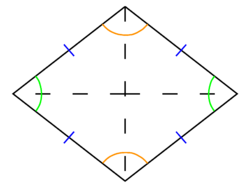Rhombus: Difference between revisions
imported>Anthony Argyriou (create) |
mNo edit summary |
||
| (6 intermediate revisions by 3 users not shown) | |||
| Line 1: | Line 1: | ||
{{subpages}} | {{subpages}} | ||
A '''rhombus''' is a [[polygon]] | {{Image|Rhombus.png|right|250px|A ''rhombus''. All sides (marked blue) are of equal length; opposite angles (same color arc) are equal; diagonals cross at right angles.}} | ||
A '''rhombus''' or '''rhomb''' is a four-sided [[polygon]] (a [[quadrilateral]]) with sides of equal length. The angles of each pair of opposite vertices are equal. A rhombus is a special case of a [[parallelogram]], a quadrilateral with equal and parallel opposite sides. A [[square]] is a special case of a rhombus, where all four vertex angles are equal to 90°. | |||
==Properties== | ==Properties== | ||
Any rhombus can [[tile (mathematics)|tile]] a plane with no voids. | As with all quadrilaterals, the sum of the interior angles of a rhombus is 360 degrees; | ||
as with a parallelogram, the angles of opposite pairs of vertices are equal, | |||
and the sum of the angles of two adjacent vertices is 180 degrees. | |||
The perimeter of a rhombus is equal to 4 times the length of one side. | |||
The area of a rhombus is equal to the length of the side multiplied by itself, | |||
multiplied by the [[sine]] of the angle between the sides. | |||
(Since sin(180-x)=sin(x) this does not depend on the choice of the angle.) | |||
Any rhombus can [[tile (mathematics)|tile]] a plane with no voids.[[Category:Suggestion Bot Tag]] | |||
Latest revision as of 06:00, 12 October 2024
A rhombus or rhomb is a four-sided polygon (a quadrilateral) with sides of equal length. The angles of each pair of opposite vertices are equal. A rhombus is a special case of a parallelogram, a quadrilateral with equal and parallel opposite sides. A square is a special case of a rhombus, where all four vertex angles are equal to 90°.
Properties
As with all quadrilaterals, the sum of the interior angles of a rhombus is 360 degrees; as with a parallelogram, the angles of opposite pairs of vertices are equal, and the sum of the angles of two adjacent vertices is 180 degrees.
The perimeter of a rhombus is equal to 4 times the length of one side. The area of a rhombus is equal to the length of the side multiplied by itself, multiplied by the sine of the angle between the sides. (Since sin(180-x)=sin(x) this does not depend on the choice of the angle.)
Any rhombus can tile a plane with no voids.
